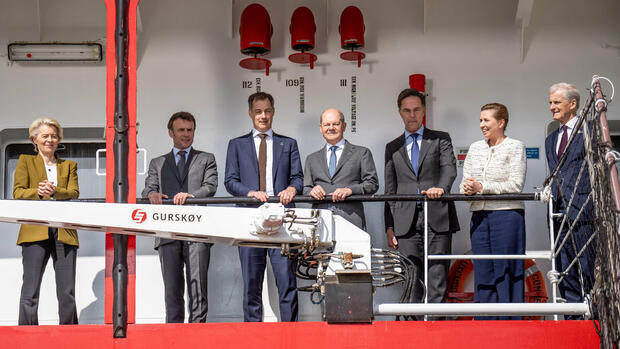The EU Commission President and the heads of state of France, Belgium, Germany, the Netherlands and Denmark discussed the expansion of wind farms in the North Sea.
(Photo: dpa)
Ostend, Brussels, Berlin, Dusseldorf The ship on which Chancellor Olaf Scholz (SPD) and his colleagues are climbing is a massive machine. Two strong cranes are part of the “Connector”, the bigger one can lift 400 tons. The “Connector” operates down to a depth of 3000 meters.
When not serving as a backdrop for a summit meeting, this ship is laying the cables that connect offshore wind farms to land. In the future, such cables are to run criss-cross through the North Sea to create a network of European wind farms that together can supply 300 million households with electricity.
The sea is to become a major supplier of green electricity – the North Sea Summit in Ostend, Belgium is about nothing less. Even the often tight-lipped Chancellor used big words on Monday: “The North Sea can become the largest power plant in the world,” said Scholz. “We need more wind energy faster to achieve our climate goals – and to become independent of Russian gas.” The energy powerhouse is right on the doorstep.
As much power as 300 nuclear power plants
Together with Belgium, the Netherlands, Luxembourg, France, Ireland, Denmark, Norway and Great Britain, the federal government wants to ensure that wind turbines with a capacity of 120 gigawatts are installed in the North Sea by 2030, and by 2050 offshore parks are even supposed to have “at least 300 gigawatts ” delivery. That would correspond to the output of 300 nuclear power plants, with wind turbines not running around the clock.
“The clear commitment of the North Sea countries to close cooperation in offshore expansion is a strong sign for Europe and climate protection,” praised Tim Meyerjürgens, Chief Operating Officer of the Dutch electricity transmission system operator Tennet. “This will further strengthen the market’s confidence in the political guidelines.”
Germany, which is now preparing to phase out coal after just phasing out nuclear energy, wants to take a leading role in renewables and deliver 30 gigawatts of offshore wind power alone by 2030. It is true that these figures also relate to the Baltic Sea; However, the focus of the expansion will be in the North Sea. The shallow water there, the favorable wind conditions and many industrial centers on the coast create good conditions there.
“In the North Sea, offshore wind power has grown into one of the most competitive energy sources in recent decades,” said Jochen Eickholt, head of turbine manufacturer Siemens Gamesa Renewable Energy, the Handelsblatt. But lately, the expansion has been sluggish. Since the first German offshore wind farm went into operation in 2010, just eight gigawatts of offshore wind power capacity have been connected to the grid in Germany.
The goal of 30 gigawatts by 2030 is therefore ambitious. In the wind farm operator industry, it is said that the capacities of the suppliers cannot be scaled at will. In addition, the logistical challenges are immense.
Which stands in the way of rapid expansion
“The expansion is anything but a sure-fire success,” warned RWE Offshore boss Sven Utermöhlen. The Essen-based energy group is planning gigawatt-sized wind farms in the North Sea. A problem that is currently arising: The financing conditions have become more difficult with the increased interest rates, which is why auction concepts are needed “that take inflation into account in order to increase investment security for manufacturers and developers and thus enable the lowest financing costs,” demands Utermöhlen .
>> Read here: Europe’s green mega-project: A complete network infrastructure for hydrogen is to be created in the North Sea
Not only the construction of the wind turbines is demanding. They have to be connected to the power grid on land at considerable expense. This is where the network operators and the regulatory authorities in the EU neighboring countries come into play. The offshore wind farms in the North Sea are to be connected to one another in the future, and the electricity produced can be distributed across countries. Corresponding projects between Denmark and Germany are already well advanced.
Networking should bring great advantages: If a country can no longer use electricity sensibly on windy days, a buyer should be found elsewhere in north-west Europe. Overall, the liquidity of the electricity markets can increase and the electricity price level can fall.
But before the “North Sea power plant” can emerge from the bold plans, massive investments in the wind farms and in the grid connection are required. The dimensions involved became clear last week: Tennet completed the award of the contract for 14 substation platforms in the North Sea, investment volume: 30 billion euros. The platforms are scheduled to be completed in 2031.
More: How Europe wants to protect submarine cables in the North Sea
